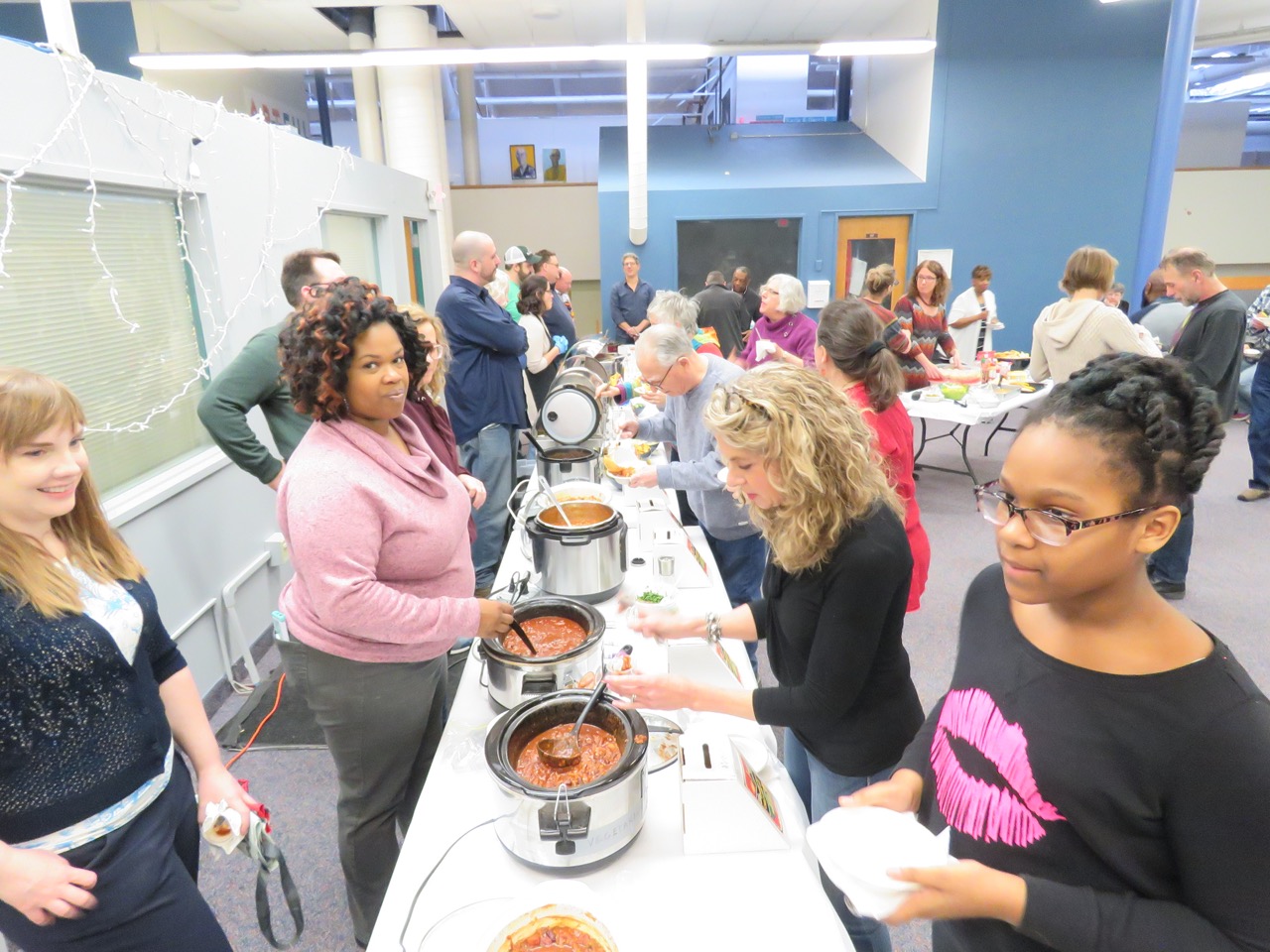Coventry P.E.A.C.E. Presentation to Library.

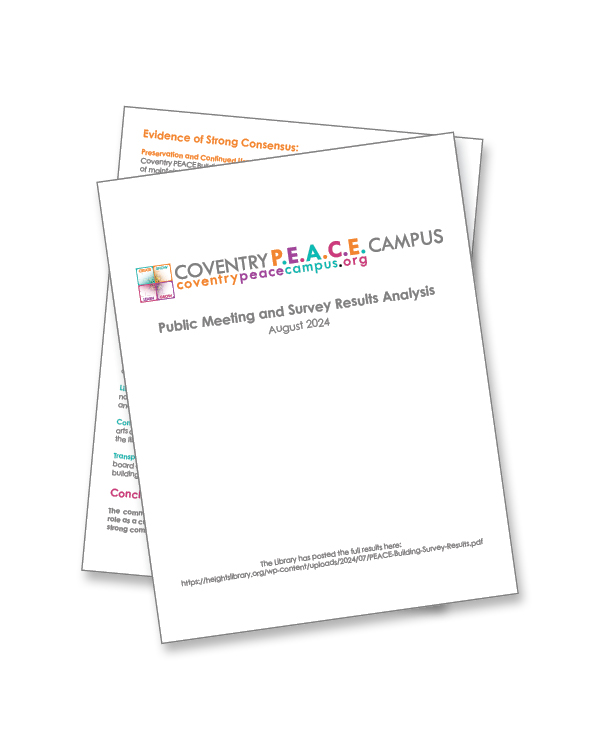
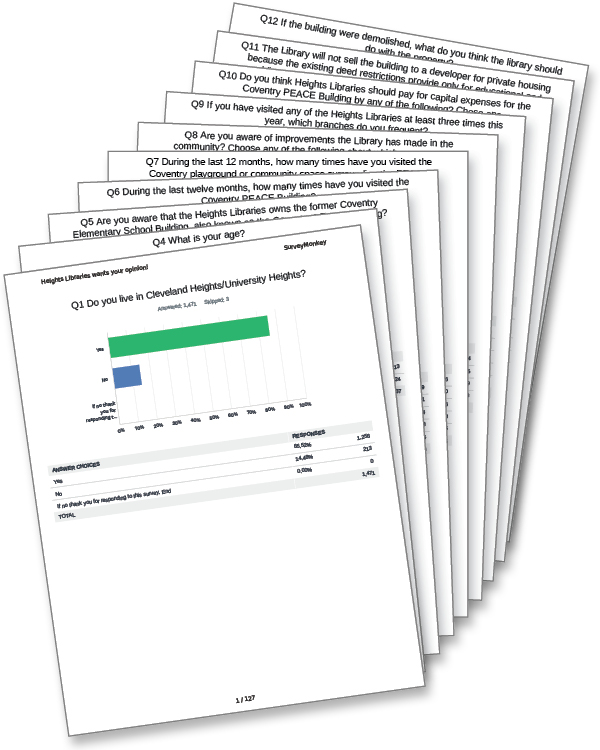
On the evening of August 5th, 2024 Coventry P.E.A.C.E. made a presentation to the Cleveland Heights – University Heights Library Board (our landlord). Our team presented a well-prepared and positive vision for the future of the Coventry P.E.A.C.E. Building, highlighting the importance of this community asset and the widespread public support for preserving this vital Arts, Culture, and Education Center.
Presentation Highlights:
- Collaborative Vision: We used our 15 minutes to outline a vision for a collaborative process aimed at achieving the outcomes that residents clearly expressed during the Library’s public meeting and survey. Our approach centers on working together with the Library, the City, and the community to preserve the Coventry P.E.A.C.E. Building as a vital Arts, Culture, and Education Center.
- Advanced Survey Analysis: We provided the Library Board members with a detailed handout that analyzed their survey results using A.I. technology. This advanced analysis offered a thorough interpretation of the data, counteracting the Library’s own analysis presented by Director Nancy Levin and Communications Manager Sheryl Banks. While the Library’s analysis was insightful, our A.I.-driven approach provided a more comprehensive understanding, particularly highlighting the community’s strong consensus against demolition and in favor of collaborative solutions.
-
-
- Of the 1,029 respondents to Question #10, apx. 90% DO support preserving the building and finding some method to pay for the building and its capital improvements.
- Of the 1,031 respondents to Question #11, apx. 76% DO NOT support demolition of the building.
- Of the 369 respondents to Question #13, apx. 80% DO support some form of preservation of the building, maintaining current tenants, or continuing its role as a nonprofit and community hub.
-
-
- Presenters and Community Voices: Krista Hawthorne (Coventry P.E.A.C.E., Inc. Board President), Cole Ware (Coventry resident, community organizer, and public policy professional), and Aaron Marcovy (Coventry resident and Community Investment & Economic Development Director for NOPEC) were key presenters. Krista emphasized the need for the Library to formally invite the City to join the discussions and highlighted the necessary steps to develop a comprehensive, collaborative plan. Cole spoke to the recent positive momentum within the Coventry neighborhood and the risks posed to that momentum if the building’s future remains uncertain. Aaron highlighted that funding is not the issue—numerous funding streams are available, but accessing these resources depends on who has site control, which is currently the Library.
Addressing Key Issues:
- City’s Role: The Library stated that the City has no interest in the building. However, we have been informed that the City is willing to engage in discussions if formally invited by the Library. This disconnect needs to be resolved to ensure a collaborative approach.
- Lack of Urgency: The Library indicated that they may not act on this matter until September and that they have given themselves until December to present options to their Board. This delay is concerning, given the critical timing for our organizations, many of which must soon decide on relocation. The potential loss to the neighborhood, residents, and businesses if our organizations are forced to scatter or close would be significant. If the Library does not act swiftly to collaborate with the City and Coventry P.E.A.C.E. on the Keep The P.E.A.C.E. effort, they risk ignoring the community’s wishes and missing an opportunity to establish the building as a permanent Arts, Culture, and Education Center. This could leave the Library with a large building that they are legally obligated to maintain for the three tenants who have leases that run through the end of 2025, with minimal subsidization from rent revenue due to the dwindling number of tenants.
- Fiscal Responsibility: We clearly communicated our understanding and agreement of the Library’s responsibility to spend taxpayer money wisely. Our proposal offers a fiscally responsible way to relieve the Library of ownership and management responsibilities without using taxpayer funds, ensuring that the Coventry P.E.A.C.E. Building can continue to serve the community.
The Path Forward:
- Form a Collaborative Working Group: Establish a working group that includes representatives from Coventry P.E.A.C.E., the Library, the City, and other key stakeholders. The group’s immediate goal should be to create a clear, actionable plan by the end of 2024 for the future of the Coventry P.E.A.C.E. Building. This includes formally inviting the City to participate in the discussions, as their involvement is crucial to finding a collaborative solution.
- Secure Site Control or Ownership Transfer: Begin the process of securing site control or negotiating an ownership transfer of the Coventry P.E.A.C.E. Building from the Library to a more appropriate entity, such as the City or a nonprofit organization. Site control is essential for accessing funding streams and moving forward with necessary capital improvements. This step will also allow for more targeted fundraising efforts and the pursuit of grants.
- Engage the Community and Funders: Continue to engage the community by organizing events, such as the upcoming P.E.A.C.E.-“full” Summer BBQ & Brainstorming Session, to gather input and maintain public support. Additionally, reach out to key institutions, funders, and potential partners who have expressed a willingness to collaborate. Their guidance and financial support will be crucial in sustaining the building and ensuring its long-term viability as an Arts, Culture, and Education Center.
Join Us for the P.E.A.C.E.-“full” Summer BBQ & Brainstorming Session:
We invite you to our P.E.A.C.E.-“full” Summer BBQ & Brainstorming Session on Sunday, August 18th, from 3-5 pm at 2843 Washington Blvd. This community potluck will feature creative brainstorming pods where we can discuss the future of the Coventry P.E.A.C.E. Building and how we can unite to find solutions. We’ll provide the hotdogs and beverages—please feel free to bring a dish to share! An R.S.V.P. is always appreciated.
Thank you for your unwavering support. Together, we can Keep The P.E.A.C.E.
PLEASE NOTE: Following the release of the survey results, the Library (landlord) announced they were postponing their planned “working group” sessions scheduled for August 8th.
Digging deeper into the “other” answers:
Support for Current Tenants: Many respondents emphasized the importance of supporting the current non-profit tenants in the building. They suggest providing long-term leases to allow these organizations to secure funding for necessary improvements and to continue their valuable community services.
Maintaining the Building: There is significant opposition to demolishing the building. Respondents prefer finding funds for capital improvements through grants, fundraising, or other means. Some also suggest reducing library expenses elsewhere to allocate funds to the PEACE Building.
Library’s Role: A common sentiment is that the library should not be in the property management business for non-library buildings. Some respondents suggest selling the building to the current tenants or another entity that can manage it better.
Community Use and Engagement: Suggestions include enhancing the building’s role as a community and arts center, increasing community engagement, and developing more programs that connect the library, the community, and local artists.
Transparency and Collaboration: Respondents call for more transparency from the library board and a collaborative approach with the current tenants to devise a sustainable plan for the building. They stress the need for open communication and a cooperative relationship.
Key take-aways from questions #1, #2, #3 & #4
Diverse Neighborhood Representation: The respondents to the survey and attendees at the Library’s public meeting come from a wide range of neighborhoods within the Cleveland Heights/University Heights area. Neighborhoods commonly represented include:
- Coventry
- Grant Deming
- Noble
- Cedar Lee
There was also significant representation from University Heights.
Diverse Age Representation: The survey responses come from a wide range of age groups, indicating that the issue of the Coventry P.E.A.C.E. building resonates across different generations within the community.
[Question #1: Do you live in Cleveland Heights/University Heights?]
[Question #2: If you live in Cleveland Heights/University Heights, what neighborhood do you live in?]
[Question #3: What is your zip code?]
[Question #4: What is your age?]
Key take-aways from questions #5, #6, #7, #8 & #9
High Awareness: A significant majority of respondents are aware that the Heights Libraries owns the Coventry PEACE Building. This indicates that the community is well-informed about the ownership and management of the building, which is crucial for meaningful engagement in discussions about its future.
A Beloved Community Hub: The Coventry P.E.A.C.E. Campus, encompassing the building, library, and park, is a cherished destination for many in our community. Even those who don’t visit regularly express strong support and take pride in the campus, its institutions, and the vibrant organizations and activities it hosts.
Awareness of Specific Improvements: A significant majority of respondents are aware of the Noble Branch and Coventry Branch improvements but only a moderate number of respondents are familiar with the Library’s P.E.A.C.E. Park initiative and improvements.
[Question #5: Are you aware that the Heights Libraries owns the former Coventry Elementary School Building, also known as the Coventry PEACE Building?]
[Question #6: During the last twelve months, how many times have you visited the Coventry PEACE Building?]
[Question #7: During the last 12 months, how many times have you visited the Coventry playground or community space surrounding the PEACE Building?]
[Question #8: Are you aware of improvements the Library has made in the community? Choose any of the following about which you are aware.]
[Question #9: If you have visited any of the Heights Libraries at least three times thisyear, which branches do you frequent?]
Key take-aways from question #10
Diverse Opinions on Funding: The survey results show a wide range of opinions on how the capital expenses should be funded.
- While there is significant support for funding the capital expenses through traditional means like tax increases or having the Cities contribute, there is also a strong interest in alternative funding approaches like:
-
- Seeking grants and/or donations.
- Involving the tenants in raising funds.
- Selling the building.
-
[Question #10: Do you think Heights Libraries should pay for capital expenses for theCoventry PEACE Building by any of the following? Chose one.
- Asking voters for a modest increase in their property taxes.
- Institute a modest cut back of library services at all of our other buildings and use the dollars we save to update theCoventry PEACE Building.
- Ask the cities of Cleveland Heights and University Heights for money to pay for the capital improvements.
- Don’t make capital improvements to the building.
- Other (please specify)]
Key take-aways from question #11
Demolition is not an option: Residents overwhelmingly do NOT support demolition of the building.
Keep the P.E.A.C.E. is preferred: The community strongly favors keeping the Coventry PEACE Building in public or non-profit use, with an emphasis on finding sustainable solutions that align with its deed restrictions.
[Question #11: The Library will not sell the building to a developer for private housing because the existing deed restrictions provide only for educational and public uses, and this will be honored. With that in mind, which of the following actions would you recommend to the library?
- Find an alternate, non-profit, public or educational use for the building that is sustainable, with funds to make necessary capital improvements. The library would not sell surrounding land or parking lot.
- Demolish the building and expand the park.
- Other (please specify)]
Key take-aways from question #12
Strong Opposition to Demolition: While this question did not allow for a response that reflects opposition to demolishing the building or an option for maintaining the current Arts, Culture and Education Center that is currently located here, many comments in the “Other” category express opposition to demolishing the building, with respondents suggesting alternative uses that preserve the structure or repurpose it for community benefit.
[Question #12: If the building were demolished, what do you think the library should do with the property?
- Enlarge the open area with lawn or meadow.
- Enlarge the Mini-Urban Forest that was recently created behind the building.
- Please use box below for your ideas.]
Key take-aways from question #13
Support for Arts and Community Spaces: The overall consensus is that the Coventry PEACE Building is a valued community asset that should be preserved and enhanced.
- The community is eager to be involved in the process and seeks transparent, collaborative solutions to ensure the building continues to serve its important role in supporting local arts, culture, and education.
[Question #13: Thank you very much for taking the time to answer this survey. Exit takes you to main library web page. Please add any comments you have in the box below.]
The positive impact of community arts programs on local economies, community engagement, property values, and crime reduction:

Economic Impact
For every $1 invested in the arts, communities see a $5 to $7 return in local economic activity.
Source: Americans for the Arts. “Arts & Economic Prosperity Report.”
Job Creation
The arts sector creates jobs at a rate of 4.61 full-time equivalent positions per $100,000 of spending.
Source: Americans for the Arts. “Arts & Economic Prosperity Report.”
Tourism Boost
Cities with vibrant arts scenes see a 25% increase in tourism revenue.
Source: National Governors Association. “New Engines of Growth: Five Roles for Arts, Culture and Design.”
Business Attraction
Companies are 35% more likely to relocate to areas with robust arts and cultural amenities.
Source: The Conference Board. “Ready to Innovate.”
Consumer Spending
Arts attendees spend an average of $31.47 per person, per event, beyond the cost of admission.
Source: Americans for the Arts. “Arts & Economic Prosperity Report.”
GDP Contribution
Arts and culture contribute more than $800 billion annually to the U.S. economy, or 4.3% of the GDP.
Source: Bureau of Economic Analysis. “Arts and Cultural Production Satellite Account.”
Startup Growth
Cities with strong arts communities see a 15% higher rate of startup growth.
Source: Urban Institute. “Arts and Culture in Urban or Regional Planning: A Review and Research Agenda.”
Tax Revenue
The arts sector generates substantial tax revenue, with local governments receiving $7.9 billion annually.
Source: Americans for the Arts. “Arts & Economic Prosperity Report.”
Economic Revitalization
Communities with active arts programs report a 20% increase in economic revitalization efforts.
Source: The National Endowment for the Arts. “Creative Placemaking.”
Sales Impact
The non-profit arts industry generates $166.3 billion in economic activity annually, supporting 4.6 million jobs.
Source: Americans for the Arts. “Arts & Economic Prosperity Report.”
Civic Engagement
Participation in community arts increases civic engagement by 28%.
Source: National Endowment for the Arts. “The Arts and Civic Engagement.”
Volunteerism
Communities with strong arts programs see a 35% increase in volunteerism.
Source: Americans for the Arts. “Arts & Economic Prosperity Report.”
Voter Participation
Arts-engaged individuals are 15% more likely to vote.
Source: National Endowment for the Arts. “The Arts and Civic Engagement.”
Social Capital
Arts participation boosts social capital, enhancing community cohesion and collaboration.
Source: Social Impact of the Arts Project (SIAP). “Cultural Indicators Project.”
Community Events
Arts programs often lead to a 50% increase in community events and gatherings.
Source: National Endowment for the Arts. “The Arts and Civic Engagement.”
Public Spaces
Arts initiatives improve public spaces, increasing their use by 30%.
Source: Project for Public Spaces. “Creative Placemaking.”
Youth Engagement
Arts programs can engage youth, reducing idle time by 40%.
Source: National Guild for Community Arts Education. “The Impact of Community-Based Arts Programs.”
Intergenerational Interaction
Arts programs foster intergenerational interaction, with a 25% increase in participation by both young and old.
Source: Americans for the Arts. “Arts & Economic Prosperity Report.”
Cultural Awareness
Arts programs enhance cultural awareness, leading to a 20% increase in community harmony.
Source: National Assembly of State Arts Agencies. “Advancing Arts Education through an Expanded School Day.”
Neighborhood Networks
Participation in the arts strengthens neighborhood networks by 22%.
Source: University of Pennsylvania. “Social Impact of the Arts Project (SIAP).”
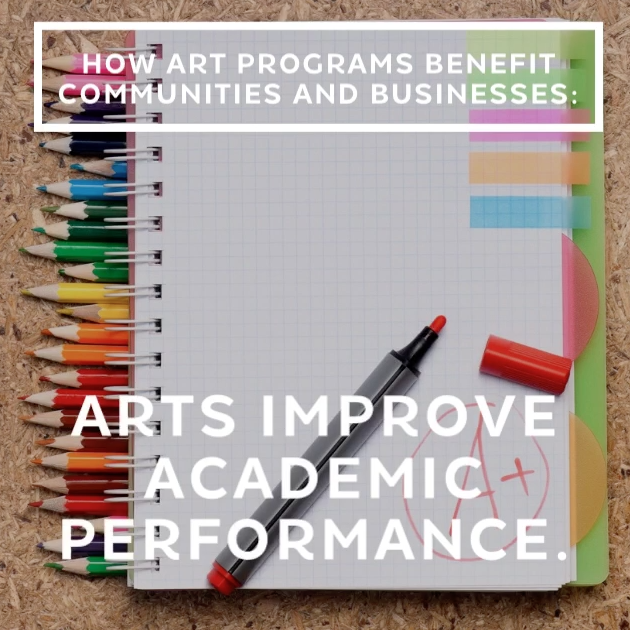
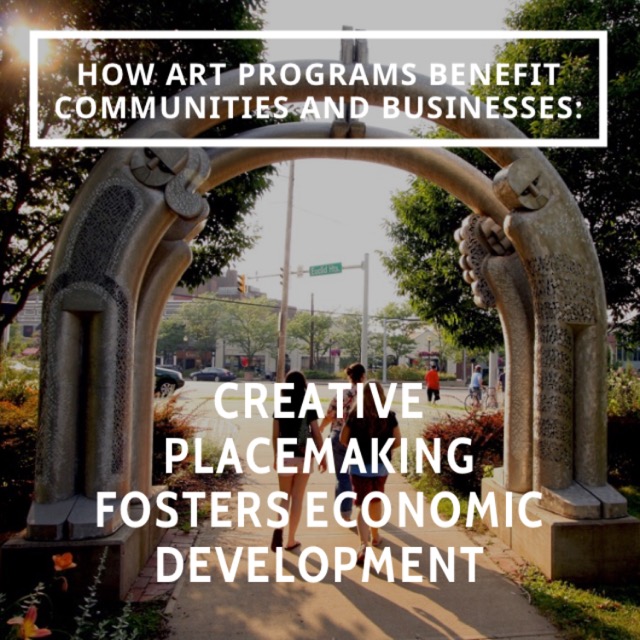
Property Value Increase
Property values in neighborhoods with active arts programs increase by 20%.
Source: American Planning Association. “How Arts and Cultural Strategies Create, Reinforce, and Enhance Sense of Place.”
Attractiveness
60% of real estate agents say properties near cultural districts are more attractive to buyers.
Source: Urban Land Institute. “Creative Placemaking in Real Estate.”
Reduced Vacancy
Arts programs contribute to a 25% reduction in property vacancies.
Source: National Endowment for the Arts. “Our Town: Arts-Based Community Development Investments.”
Urban Renewal
Arts initiatives play a key role in urban renewal, leading to a 15% increase in property investments.
Source: National Endowment for the Arts. “The Arts and Economic Growth.”
Historic Preservation
Arts programs often contribute to the preservation and revitalization of historic properties, increasing their value by 18%.
Source: The National Trust for Historic Preservation. “The Impact of Arts and Culture on Historic Preservation.”
Community Investment
Neighborhoods with arts programs see a 30% increase in community investment.
Source: Americans for the Arts. “Arts & Economic Prosperity Report.”
Public Perception
Public perception of safety and attractiveness increases by 35% in areas with visible arts programs.
Source: The Trust for Public Land. “Creative Placemaking: Integrating Art into Public Spaces.”
New Developments
Areas with strong arts communities attract 25% more new developments.
Source: Urban Institute. “Arts and Culture in Urban or Regional Planning: A Review and Research Agenda.”
Commercial Value
Commercial properties near arts districts see a 15% increase in value.
Source: National Endowment for the Arts. “How the Arts Impact Property Values.”
Juvenile Delinquency Reduction
Participation in arts programs is associated with a 29% reduction in juvenile delinquency and youth crime rates.
Source: The National Endowment for the Arts. “The Arts and Achievement in At-Risk Youth.”
After-School Arts Programs
After-school arts programs reduce risky behavior in youth by 71%.
Source: The YouthARTS Development Project. “YouthARTS: Arts Programs for Youth At Risk.”
Gang Involvement
Arts education decreases the likelihood of gang involvement by providing constructive and engaging activities.
Source: Justice Arts Coalition. “Impact of Arts on Recidivism.”
Community Cohesion
Neighborhoods with active arts programs report a 25% decrease in neighborhood crime rates due to increased community cohesion.
Source: The Urban Institute. “The Arts and Community Safety.”
Violence Prevention
Communities with robust arts programs see a 20% reduction in violence-related incidents.
Source: The American Journal of Public Health. “The Connection Between Art, Healing, and Public Health.”
Conflict Resolution Skills
Arts programs improve conflict resolution skills, decreasing interpersonal violence by 30%.
Source: Americans for the Arts. “The Arts and Conflict Resolution.”
Substance Abuse Prevention
Youth engaged in arts programs are 55% less likely to use drugs compared to their peers.
Source: National Endowment for the Arts. “The Arts and Achievement in At-Risk Youth.”
Safer School Environments
Schools with strong arts curricula report 45% fewer disciplinary issues.
Source: The Center for Arts Education. “Staying in School: Arts Education and New York City High School Graduation Rates.”
Neighborhood Safety
Residents in arts-rich neighborhoods feel 30% safer.
Source: National Endowment for the Arts. “Creative Placemaking: Improving Safety in Public Spaces.”
Community Pride
Community arts programs increase local pride, leading to a 20% reduction in vandalism.
Source: Americans for the Arts. “The Social Impact of the Arts.”
Public Art
The presence of public art is linked to a 15% decrease in property crimes.
Source: Project for Public Spaces. “Creative Placemaking.”
Street Engagement
Areas with street arts and performances see a 25% reduction in petty crime.
Source: National Endowment for the Arts. “How Arts Programming Reduces Crime.”
Youth Employment
Arts programs provide employment opportunities for youth, reducing crime by 20%.
Source: The Aspen Institute. “Youth Employment Programs: An Economic Impact Analysis.”
Mentorship
Arts programs with mentorship components reduce youth crime by 35%.
Source: The National Endowment for the Arts. “The Arts and Achievement in At-Risk Youth.”
School Attendance
Students involved in arts programs have a 30% higher school attendance rate, reducing truancy-related crimes.
Source: The National Endowment for the Arts. “The Arts and Achievement in At-Risk Youth.”
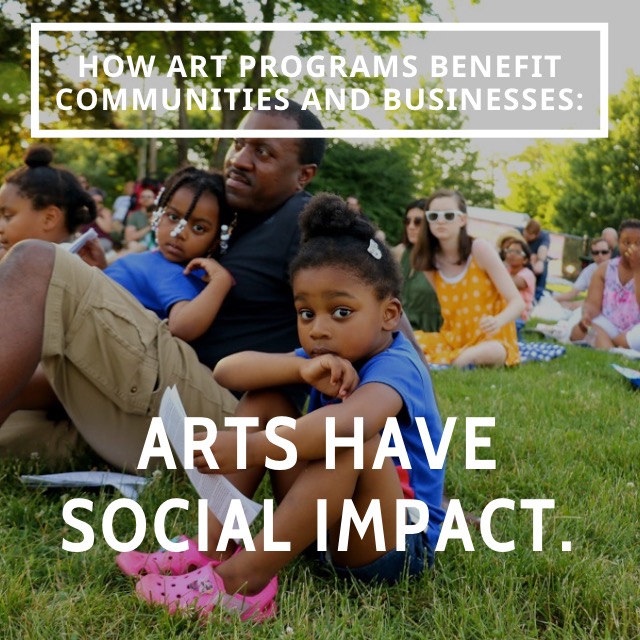
List of supporters
If you believe in the Coventry PEACE Campus Project, and the organizations we support, please add your name to our supporters list. By sharing with our community the names of those who want to see this project carried forward, you can inspire others to join us, too.
Come to our P.E.A.C.E. Pops Event
We certainly hope this will not be our last P.E.A.C.E. Pops, but it just might be. So, please mark your calendar now! Our Halloween P.E.A.C.E. Pops is one of our most popular events of the year. There's fun for ALL ages. In addition to Open Studios at ARTFUL, we'll also have Spooky Stories with Lake Erie Ink, a haunted tunnel and black light drawing area, professionally led line-dancing, a room-sized board game, giant, wandering P.E.A.C.E. puppets, cocktails & more!
Advocacy toolkit
Download a digital version of our advocacy toolkit and share with others.
Sign up for emails
Be sure you are receiving our latest news and event listings.
Get our graphics
Use our images for your social media profiles and cover images.
Watch and share the videos below.
Stay up-to-date on the latest Coventry PEACE Campus news and events – sign up to receive emails or follow us on social media.
Emails & Newsletters
Occassionally we send out updates, event information and newsletters via email. Click on the link below to sign up to receive information via email.
Social Media.
Coventry PEACE Campus can be found on several social media platforms. Click on the button below to find us online and be sure to like/follow us!
What is Coventry PEACE Campus?
When the school district sought to divest itself from the former Coventry Elementary School building in 2017, leaving its future uncertain, the leaders of all the tenant organizations and a broad base of community supporters came together in a grassroots movement to propose ways to preserve and grow the thriving arts, culture and education hub that had organically taken root there. From this effort, the Coventry PEACE Campus came into being. The Coventry P.E.A.C.E. building currently houses a dozen local and regional nonprofits. It is our goal to provide an accessible, sustainable, more efficient, and affordable home for these nonprofits, and to attract new organizations to the building.


